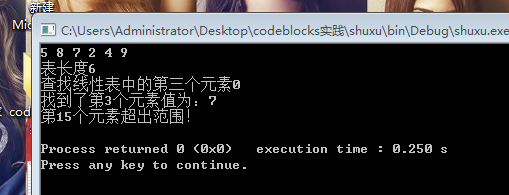问题及代码:
/*
*Copyright (c) 2014,烟台大学计算机学院
*All rights reserved.
*文件名称:建设"顺序表"算法库
*作者:李子伦
*完成日期:2015年9月19日
*
*问题描述:针对线性表中的顺序存储结构,实现各种基本运算
*输入描述:测试函数的输入
*程序输出:测试结果
*/#ifndef LIST_H_INCLUDED
#define LIST_H_INCLUDED
#include<stdio.h>
#include<malloc.h>
#define MaxSize 50 //Maxsize将用于后面定义存储空间的大小
typedef int ElemType; ElemType在不同场合可以根据问题的需要确定,在此取简单的int
typedef struct
{
ElemType data[MaxSize];
int length;
} SqList;
void CreateList(SqList *&L, ElemType a[], int n);
void DispList(SqList *L);
bool ListEmpty(SqList *L);
int ListLength(SqList *L);
int LocateElem(SqList *L, ElemType e);
bool GetElem(SqList *L,int i,ElemType &e);
void DestroyList(SqList *&L);
void InitList(SqList *&L);
bool ListInsert(SqList *&L, int i, ElemType e);
#endif
#include "1.h"
#include <stdio.h>
#include <malloc.h>
void DestroyList(SqList *&L) //销毁线性表
{
free(L);
}
bool ListInsert(SqList *&L, int i, ElemType e) //插入线性表
{
int j;
if(i<1 || i>L->length+1)
return false;
i--;
for(j=L->length;j>i;j--) //将date[i]及后面的元素后移一个位置
L->data[j]=L->data[j-1];
L->data[i]=e;
L->length++;
return true;
}
void InitList(SqList *&L) //初始化线性表
{
L=(SqList *)malloc(sizeof(SqList));
L->length=0;
}
void DispList(SqList *L) //输出线性表
{
int i;
if (ListEmpty(L))
return;
for(i=0; i<L->length; i++)
printf("%d ",L->data[i]);
printf("\n");
}
bool ListEmpty(SqList *L) //判断链表是否存在
{
return(L->length==0);
}
void CreateList(SqList *&L, ElemType a[], int n) //判断链表是否为空表
{
int i;
L=(SqList *)malloc(sizeof(SqList));
for (i=0; i<n; i++)
L->data[i]=a[i];
L->length=n;
}
int ListLength(SqList *L) //求线性表长度
{
return(L->length);
}
int LocateElem(SqList *L, ElemType e) //查找线性表中的元素
{
int i=0;
while(i<L->length&&L->data[i]!=e)
i++;
if(i>=L->length)
return 0;
else
return i+1;
}
bool GetElem(SqList *L, int i, ElemType &e) //查找某个元素并输出真假
{
if (i<1 || i>L->length)
return false;
e=L->data[i-1];
return true;
}
#include<stdio.h>
#include<malloc.h>
#include "1.h"
int main()
{
SqList *sq;
ElemType x[6]= {5,8,7,2,4,9};
ElemType a;
CreateList(sq, x, 6);
DispList(sq);
printf("表长度%d\n",ListLength(sq));
printf("查找线性表中的第三个元素%d\n",LocateElem(sq, 3));
if(GetElem(sq, 3, a)) //测试在范围内的情形
printf("找到了第3个元素值为:%d\n", a);
else
printf("第3个元素超出范围!\n");
if(GetElem(sq, 15, a)) //测试不在范围内的情形
printf("找到了第15个元素值为:%d\n", a);
else
printf("第15个元素超出范围!\n");
return 0;
}
运行结果:
知识点总结:
采用程序的多文件组织模式,建设出了顺序表的算法库,通过使用不同的测试函数,实现了算法程序化。
心得体会:
多文件组织在大型程序中有很大的方便,同时也能为日常调试的程序提供方便。

























 被折叠的 条评论
为什么被折叠?
被折叠的 条评论
为什么被折叠?








